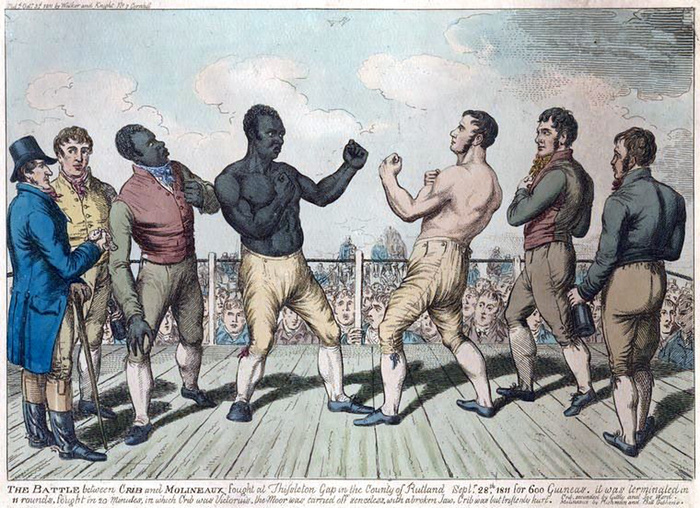“…but Odysseus gave Irus a blow on the neck under the ear that broke in the bones of his skull, and the blood came gushing out of his mouth; he fell groaning in the dust, gnashing his teeth and kicking on the ground, but the suitors threw up their hands and nearly died of laughter…”
-Homer, The Odyssey
Two men are playing cards at a brandy shop in London. It is the year 1725. A third man favors one opponent, and alerts him of the contents of the other’s cards. Incensed and feeling cheated, our player challenges the rat to a boxing match there in the store. The defeat is swift, but our man hasn’t had enough! He challenges his friend, who throws down his hand and raises two more in fisticuffs. Perhaps it is the brandy, but the defeat is swifter still, and as the cheater falls, he injures his neck, and perishes the next day. Our 2-0 champion is found guilty of manslaughter and branded with an M (for murder) for his crime.
It wouldn’t be long before 1743, when boxing champion Jack Broughton released Broughton’s rules, a set of guidelines that would reduce boxing deaths and kick off the modern era of boxing, but first let’s cover the oft sordid beginnings of pugilism.
 Boxing was first portrayed on a stone tablet in ancient Sumeria. In the image, our fighters fists and legs are crossed as though the fight has yet to start. Perhaps some ancient bell smelted from bronze off-tablet is waiting to officiate the match. It is obvious from various depictions emerging from different cultures that gloves and other elements were introduced over time, which should hardly be surprising to anyone familiar with how often the rules of basketball change, or how evolution works in general.
Boxing was first portrayed on a stone tablet in ancient Sumeria. In the image, our fighters fists and legs are crossed as though the fight has yet to start. Perhaps some ancient bell smelted from bronze off-tablet is waiting to officiate the match. It is obvious from various depictions emerging from different cultures that gloves and other elements were introduced over time, which should hardly be surprising to anyone familiar with how often the rules of basketball change, or how evolution works in general.
In 688 B.C. boxing was lifted from the tablets to become an Olympic event, and the sport quickly gained popularity in amphitheaters across the Roman empire. In place of rounds, opponents would just beat on each other until one of them submitted. The addition of leather wrappings kept boxer’s hands from breaking over each other’s faces, keeping the assailants in the match longer, and shifting the ratio of injury in favor of the one doing the most punching. Weight categories were yet to be established, so heavyweights dominated the field. Alas, the Romans were as vicious as they were clever, and soon metal studs and braces were added for additional impact.

As one of the few people notable enough in history to go by his first name, Galen (of Pergamon) was a renowned medical researcher who pushed forward the development of anatomy, physiology, pharmacology, pathology, logic, and philosophy. Galen made his way from Turkey to Rome to further his studies. Of the Roman athlete he had this to say:
“…when the athletes grow old, they creep, wrinkle and squint due to the severe blows; their eyes fill with catarrhal liquids, their teeth fall, and their bones become porotic and break easily”.
Most athletes were slaves, and, until really, really late in the game, Romans didn’t really care about what happened to slaves, so a little extra injury on the part of a combatant was worth the spectacle, which constantly needed to be trumped up to higher levels of absurd brutality to compete with the draw of human and animal sacrifice. This demand for bloodshed led to the addition of spikes to the gloves, a hat tip to the Wolverine if ever we saw one.
Things just devolved from there, and by the time Seneca showed up, his philosophy of stoicism was being completely validated:
“By chance I went to one of the mid-day shows, expecting some fun, wit and relaxation… The men have no armour and their entire bodies are exposed to blows, so no one strikes in vain. Many spectators prefer this to the ordinary pairings and even the contests given by popular request. Of course they prefer it! There is no helmet and no shield to stop the weapons… In the morning men are thrown to lions and bears: but it is to the spectators they are thrown at noon.”
In 393 A.D., it was decided that boxing was just too edgy, and the Romans abolished it before eventually just collapsing altogether, leading to a thousand year spell of plagues, bad science, and zero organized boxing tournaments. Italians revived the sport in the 12th century, but it wouldn’t rise to prominence again until “prizefighting” emerged in England in the 16th century.
Much to the delight of pugilism enthusiasts everywhere, boxing history officially resumes when Duke Christopher of Moncik of Albemarie, a man destined to become Lieutenant Governor of Jamaica, put on a match between his butler and his butcher in a manner not dissimilar to a boy pitting the insects in his mother’s garden against one another. You may be more impressed if Sir Duke of Honorableness had engaged in the bout himself, but understand it would be unbecoming of a proper Englishman of the time to fight with his own two hands.

New rules allowed contestants to take a knee mid-combat, ending the round and making time for recovery. However, this option was frowned upon as being unmanly, and amendments penalized the act until the rule eventually succumbed. Nevertheless, boxing picked up steam, and manuals were published teaching the craft of punching a man into submission, stressing the importance of striking the head with your full weight behind you. The result was a lot of traumatic brain injuries until the sport was modernized by one particularly talented pugilist named Jack Broughton.
Check out our line of athletic supports to prevent injuries, boost recovery, while looking like a boss.
Want more articles like this? Leave a rating:
- Readers Rating
-
Rated 5 stars
5 / 5 ( Reviewers) - Spectacular
- Your Rating
-




